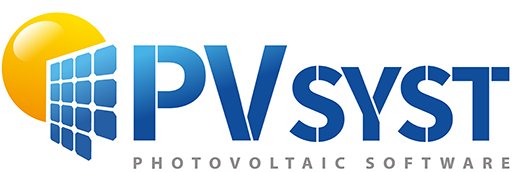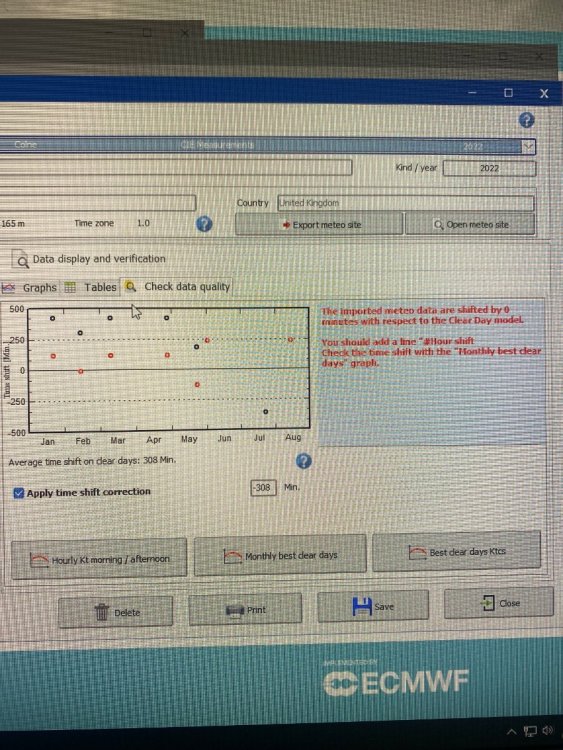Search the Community
Showing results for tags 'meteo data'.
-
Good day, Recently PVGIS has updated to the new version 5.3 but I am not able to import meteo data from this version. In PVSyst I'm only able to select version 5.2 or 5.1, in the online portal from PVGIS I'm able to download the meteo data in ccv, json or epw, but I can't figure out how to import these datafiles into datafiles into PVSyst. Could you help me with this problem? Thank you in advance, Jan Kleppe Generation Green
-
Good afternoon PVsyst team, I am reaching out to you in order to check if your team could clear a doubt our technical team has. Regarding the meteorological databases our team already checked that PVsyst team did a study comparing some of them. However, some databases such as Solargis, Solaranywhere and Solcast are not included in this study. Hence, our team has some questions: Does your team have any recommendation on this ones? Comparing these three, what are the differences, in the results values (GHI and Specific Production) between them? Does your team have a preferred database that you consider as most accurate? Anyway, we highly appreciate your opinion/recommendation on these 3 databases (Solargis, Solaranywhere and Solcast). Thank you for your attention and availability. Best regards, Nuno Graça
-
Good afternoon PVsyst team, My name is Nuno and I work in a Renewable Energy company as a PV Design Engineer and our team has some doubts that we would like to clarify, but we feel that we need your input, since your team is the one that developed the software and knows everything in detail. The main doubt that our team struggling with is regarding the Design's Temperature Parameters. I am attaching to this post 2 PDF files which contains the weather data measured by a weather station near the project location (9 km far away, approximately). The Temperature_Full_Days.pdf file shows the temperature measured during the 24 hours of each day considered and the Temperature_Sunny_Hours.pdf file shows the temperature measured during the sunny hours of each day considered. As you can see in the Temperature_Sunny_Hours.pdf file, in 1800 hours of sun (from 8 a.m. until 5 p.m. - during the months of December 2021, January 2022, February 2022, December 2022, January 2023 and February 2023), we got 105 hours where the hourly average temperature was lower than -20 ºC and 20 hours where the hourly average temperature was lower than -25 ºC. Our question is: Shall we consider the Lower Temperature for Absolute Voltage Limit as -25 ºC? Shall we consider it as the minimum temperature of the sunny hours of these months (-28.5 ºC)? Or shall we consider it as the minimum temperature of all hours of these months (-29.4 ºC)? Also, could you please tell us what would be the implications and consequences if we have considered a higher temperature than the one we should consider? If you need more information, like the PVsyst Project file and all the weather data that we have, just let me know. Looking forward for your answer and thank you for your attention and availability.
-
Hi, I imported a Meteo file but I can’t save it because I keep getting the error attached. I’d appreciate any help please.
-
Hi, my name is Raul and I´m trying to import to PVS a TMY file that I did with a 3 year period real life data (see attached image), I did the following: 1) ) I took as a template a vaisala format, and substitute the vaisala numbers by the ones of the TMY I did with the real measure data. 2) I tried to upload the file using the Known format menu at the meteo bata base menu, but it do not recognize the file. Could you please let me know to import real world data into PVsyst for be used in a simulation. Thanks in advance. Best regards
-
Hello forum users, i am doing some research on the various Horizon sources available. i have chosen some meteo data i have used for previous projects and i would like to do a series of analysis for each one of them using: 1 - SolarGIS Horizon profile 2 - Meteonorm Horizon (from PVsyst web sources) 3 - PVGIS Horizon (from PVsyst web sources) my goal is to: compare the "far shading losses" and the Horizon line drawings considering the different Horizon data so to have a general overview of the differences between the Horizon datasets; of course my research will also include the study of the manuals and theory behind the definition of the Horizon profile provided by each one of the three Meteo database. i would like to raise a couple of questions: how far has to be an obstacle to be actually considered in the far shadings? considering the high dependency of the horizon from the exact geographical coordinates, are there any suggestion on the horizon profile choice regarding big PV plants? has someone of you undergone some similar studies? have you found some interesting results? also, considering point 2, a question for the software developers: are you considering a possible software update that would allow the user to set different horizon profiles, perhaps linking a single profile to a single subfield? thank you very much in advance for your contribution! Davide
- 8 replies
-
- horizon
- meteo data
-
(and 8 more)
Tagged with:
-
Hello, I want to know the ambient temperature used in the monthly meteo data is which monthly average? Average of High Daily Temperatures Average of Low Daily Temperatures Average of Mean Daily Temperatures Thanks in advance
-
I would very much have liked a function for importing albedo and snow data directly from Meteonorm, as this is something that is used frequently in our simulations. Instead of having to import this data from Meteonorm manually, the proposed function would provide ease of use to the UI in the same way that direct import of a horizon did. We currently download snow depth data from local weather stations, when possible, for use in the Marion model, which enables the creation of a soiling profile due to snow. The same data is available from Meteonorm and together with data on temperature and irradiance allows for creating a snow profile when no local data is available. Would this be difficult to integrate in PVsyst?
- 1 reply
-
- meteo data
- albedo
-
(and 1 more)
Tagged with:


